Numerical Simulation on Transient Pressure Pulsations and Complex Flow Structures of a Ultra-High-Speed Centrifugal Pump at Stalled Condition
Abstract
:1. Introduction
2. Numerical Setup
2.1. The Ultra-High-Speed Centrifugal Pump for Investigation
2.2. Numerical Scheme
3. Results and Discussions
3.1. Global Performance of the Ultra-High-Speed Centrifugal Pump
3.2. Unsteady Pressure Pulsations at Various Flow Rates
3.3. Complex Flow Structures within the Impeller
4. Conclusions
Author Contributions
Funding
Data Availability Statement
Conflicts of Interest
Nomenclature
| Qd | Flow capacity, m3/h |
| Hd | Pump head, m |
| Pd | Rated shaft power, W |
| nd | Shaft speed, r/min |
| ns | Pump-specific speed |
| ΦN | Flow capacity coefficient |
| ΨN | Head coefficient |
| λN | Power coefficient |
| Zr | Total blade number of the impeller |
| η | Efficiency |
| D1 | Suction diameter, mm |
| D2 | Impeller outlet diameter, mm |
| D4 | Volute outlet diameter, mm |
| ϕ | Wrap angle, ° |
| u2 | Tangential speed at the impeller outlet, m/s |
| β2 | Blade outlet angle, ° |
| ρ | Water density, m3/h |
| fn | Shaft rotating frequency, Hz |
| fBPF | Blade passing frequency, Hz |
| RSI | Rotor-stator interaction |
| t | Time, s |
| Δt | Time step, s |
| A | Pressure pulsation amplitude, Pa |
| y+ | Value of y plus |
| cp | Pressure coefficient |
| RMS | Root mean square |
References
- Weijun, W.; Tailong, L.I. Optimum design of centrifugal aviation fuel pump based on splitter blades technology. Eng. J. Wuhan Univ. 2021, 54, 557–562. [Google Scholar]
- Li, D.; Ren, Z.; Li, Y.; Miao, B.; Gong, R.; Wang, H. Thermodynamic Effects on Pressure Fluctuations of a Liquid Oxygen Turbopump. J. Fluids Eng. Trans. ASME 2021, 143, 111401. [Google Scholar] [CrossRef]
- Posa, A.; Lippolis, A. A LES investigation of off-design performance of a centrifugal pump with variable-geometry diffuser. Int. J. Heat Fluid Flow 2018, 70, 299–314. [Google Scholar] [CrossRef]
- Posa, A. LES investigation on the dependence of the flow through a centrifugal pump on the diffuser geometry. Int. J. Heat Fluid Flow 2021, 87, 108750. [Google Scholar] [CrossRef]
- Yuan, Y.; Yuan, S. Analyzing the effects of splitter blade on the performance characteristics for a high-speed centrifugal pump. Adv. Mech. Eng. 2017, 9, 1–11. [Google Scholar] [CrossRef]
- Zhang, J.; Yang, H.; Liu, H.; Xu, L.; Lv, Y. Pressure Fluctuation Characteristics of High-Speed Centrifugal. Processes 2021, 9, 2261. [Google Scholar] [CrossRef]
- Guo, X.; Jiang, C.; Qian, H.; Zhu, Z. The Influence of Tip Clearance on the Performance of a High-Speed Inducer Centrifugal Pump under Different Flow Rates Conditions. Processes 2023, 11, 239. [Google Scholar] [CrossRef]
- Chao, W.X.; Shi, B.L.; Ruan, H.; Dong, W. The Cavitation Characteristics of High Speed Centrifugal Pumps with Different Impeller Types. Front. Energy Res. 2022, 10, 811690. [Google Scholar] [CrossRef]
- Zhang, N.; Li, D.; Jiang, J.; Gao, B.; Ni, D.; Alubokin, A.A. Experimental Investigation on Velocity Fluctuation in a Vaned Diffuser Centrifugal Pump Measured by Laser Doppler Anemometry. Phys. Fluids 2023, 32, 125108. [Google Scholar] [CrossRef]
- Zhang, N.; Jiang, J.; Gao, B.; Liu, X. DDES analysis of unsteady flow evolution and pressure pulsation at off-design condition of a centrifugal pump. Renew. Energy 2020, 153, 193–204. [Google Scholar] [CrossRef]
- Zhang, N.; Liu, X.; Gao, B.; Wang, X.; Xia, B. Effects of modifying the blade trailing edge profile on unsteady pressure pulsations and flow structures in a centrifugal pump. Int. J. Heat Fluid Flow 2019, 75, 227–238. [Google Scholar] [CrossRef]
- Ni, D.; Zhang, N.; Gao, B.; Li, Z.; Yang, M. Dynamic measurements on unsteady pressure pulsations and flow distributions in a nuclear reactor coolant pump. Energy 2020, 198, 117305. [Google Scholar] [CrossRef]
- Barrio, R.; Parrondo, J.; Blanco, E. Numerical analysis of the unsteady flow in the near-tongue region in a volute-type centrifugal pump for different operating points. Comput. Fluids 2010, 39, 859–870. [Google Scholar] [CrossRef]
- Keller, J.; Blanco, E.; Barrio, R.; Parrondo, J. PIV measurements of the unsteady flow structures in a volute centrifugal pump at a high flow rate. Exp. Fluids 2014, 55, 1820. [Google Scholar] [CrossRef]
- Feng, J.; Ge, Z.; Yang, H.; Zhu, G.; Li, C.; Luo, X. Rotating stall characteristics in the vaned diffuser of a centrifugal pump. Ocean Eng. 2021, 229, 108955. [Google Scholar] [CrossRef]
- Ullum, U.; Wright, J.; Dayi, O.; Ecder, A.; Soulaimani, A.; Piché, R.; Kamath, H. Prediction of rotating stall within an impeller of a centrifugal pump based on spectral analysis of pressure and velocity data. J. Phys. Conf. Ser. 2006, 52, 36–45. [Google Scholar] [CrossRef]
- Zhang, N.; Gao, B.; Ni, D.; Liu, X. Coherence analysis to detect unsteady rotating stall phenomenon based on pressure pulsation signals of a centrifugal pump. Mech. Syst. Signal Process. 2021, 148, 107161. [Google Scholar] [CrossRef]
- Zhao, X.; Xiao, Y.; Wang, Z.; Luo, Y.; Cao, L. Unsteady flow and pressure pulsation characteristics analysis of rotating stall in centrifugal pumps under off-design conditions. J. Fluids Eng. Trans. ASME 2018, 140, 021105. [Google Scholar] [CrossRef]
- Zhang, N.; Liu, X.; Gao, B.; Xia, B. DDES analysis of the unsteady wake flow and its evolution of a centrifugal pump. Renew. Energy 2019, 141, 570–582. [Google Scholar] [CrossRef]
- Zore, K.; Sasanapuri, B.; Parkhi, G.; Varghese, A. Ansys mosaic poly-hexcore mesh for high-lift aircraft configuration. In Proceedings of the 21th Annual CFD Symposium, Bengaluru, India, 8–9 August 2019; pp. 1–11. [Google Scholar]
- Gao, B.; Zhang, N.; Li, Z.; Ni, D.; Yang, M.G. Influence of the Blade Trailing Edge Profile on the Performance and Unsteady Pressure Pulsations in a Low Specific Speed Centrifugal Pump. J. Fluids Eng. Trans. ASME 2016, 138, 051106. [Google Scholar] [CrossRef]
- Posa, A. LES study on the influence of the diffuser inlet angle of a centrifugal pump on pressure fluctuations. Int. J. Heat Fluid Flow 2021, 89, 108804. [Google Scholar] [CrossRef]
- Posa, A.; Lippolis, A. Effect of working conditions and diffuser setting angle on pressure fluctuations within a centrifugal pump. Int. J. Heat Fluid Flow 2019, 75, 44–60. [Google Scholar] [CrossRef]
- Zhang, N.; Li, D.; Gao, B.; Ni, D.; Li, Z. Unsteady Pressure Pulsations in Pumps—A Review. Energies 2023, 16, 150. [Google Scholar] [CrossRef]
- Li, D.L.; Zhang, N.; Jiang, J.X.; Gao, B.; Alubokin, A.A.; Zhou, W.J.; Shi, J.L. Numerical investigation on the unsteady vortical structure and pressure pulsations of a centrifugal pump with the vaned diffuser. Int. J. Heat Fluid Flow 2022, 98, 109050. [Google Scholar] [CrossRef]
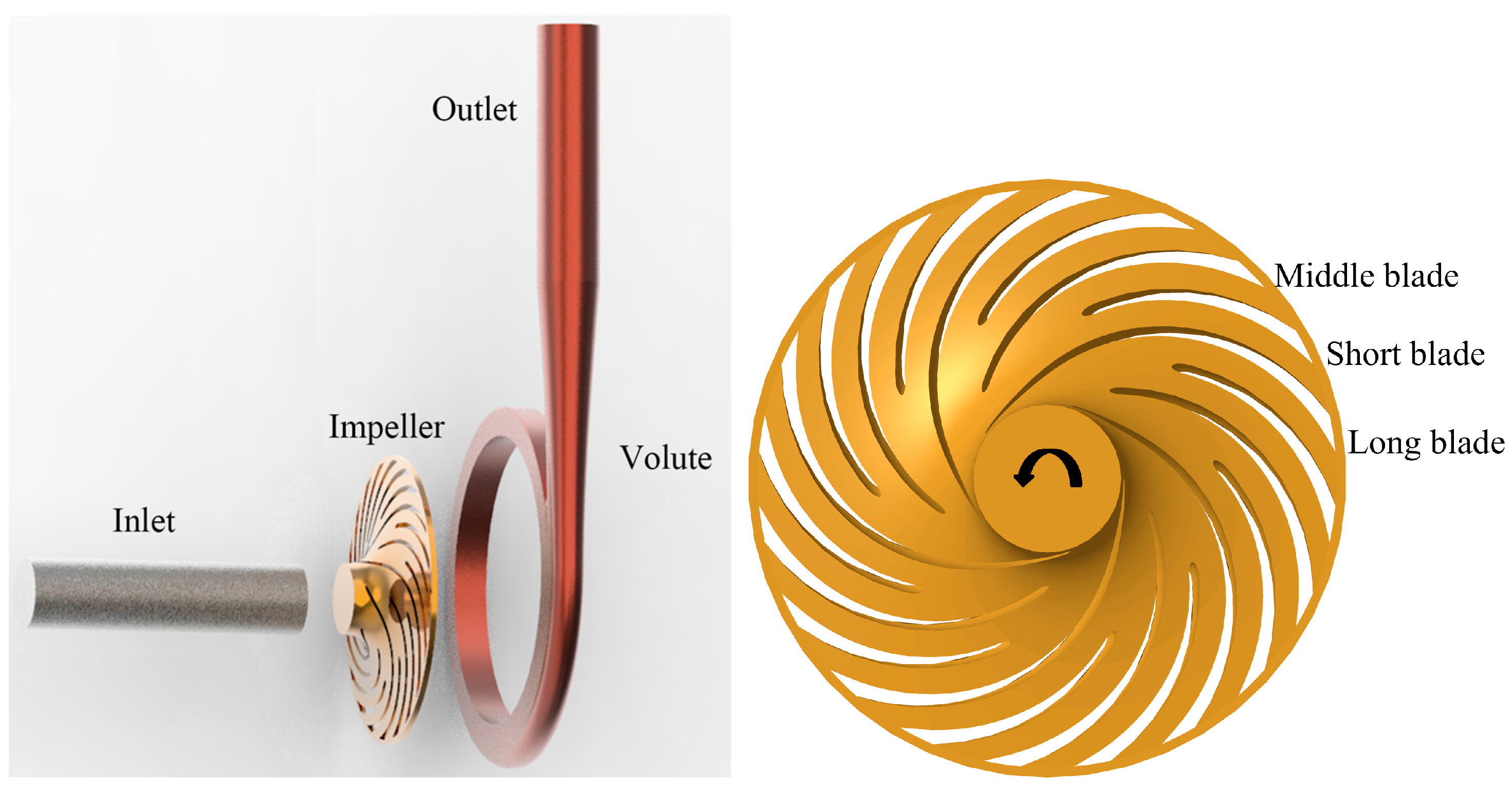
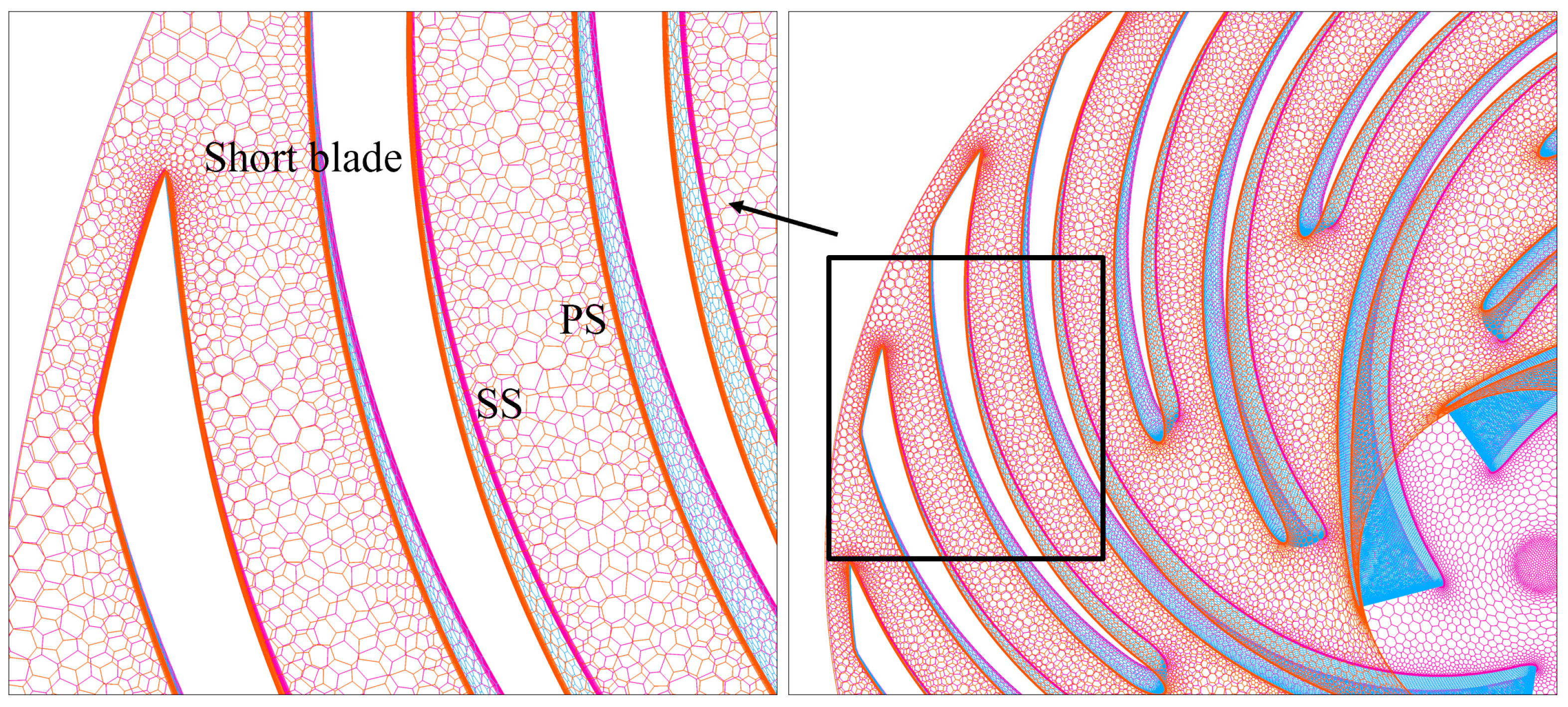

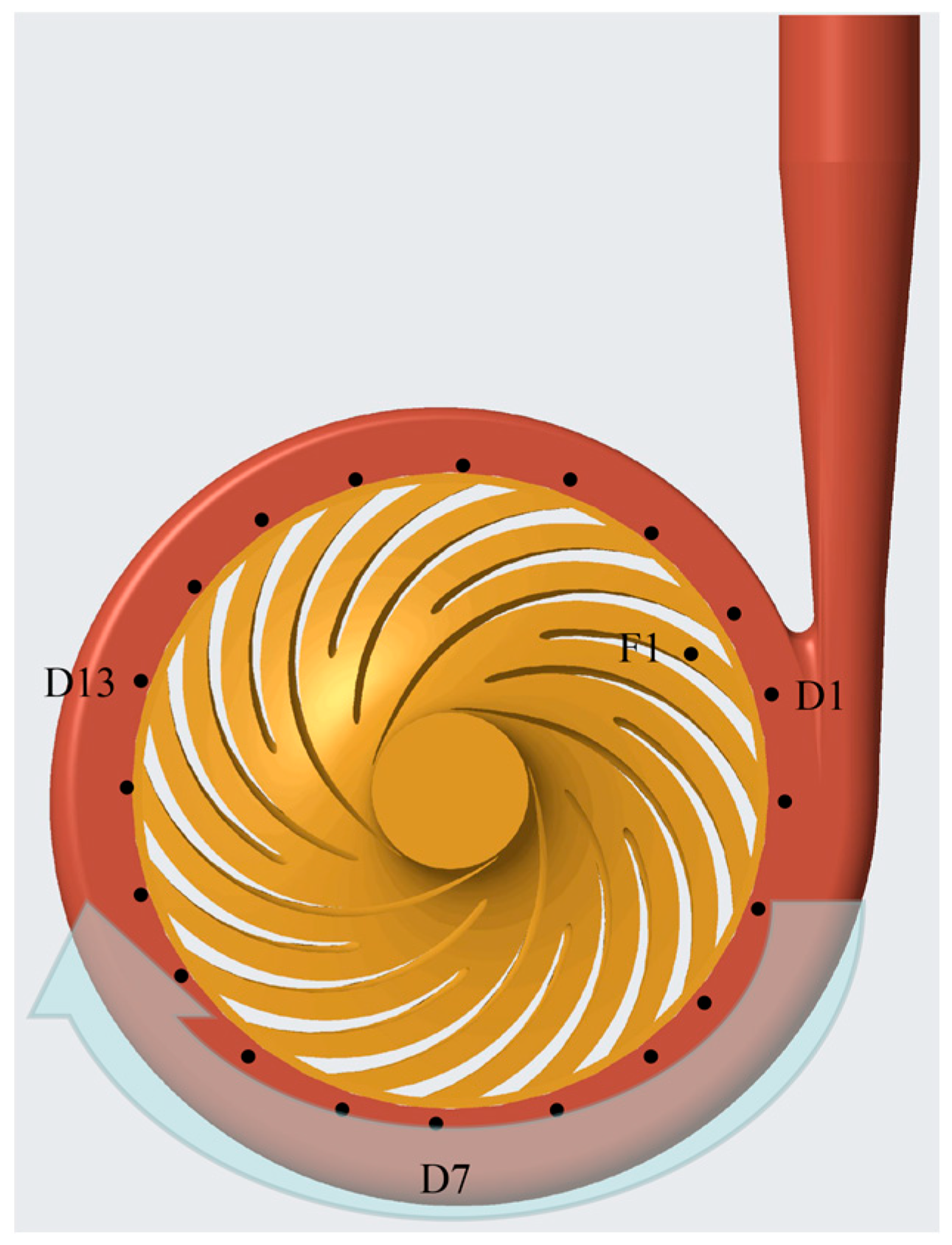
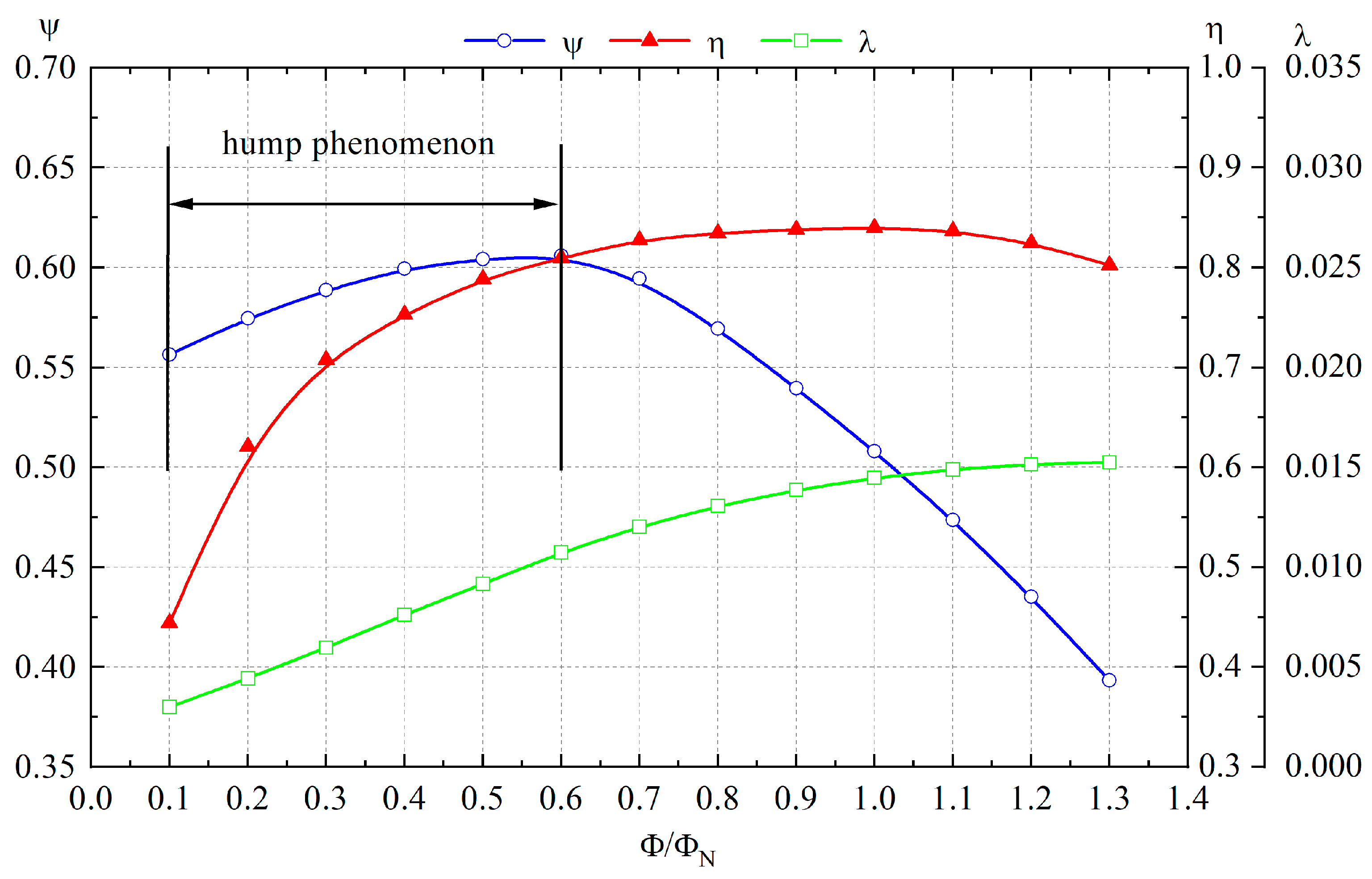
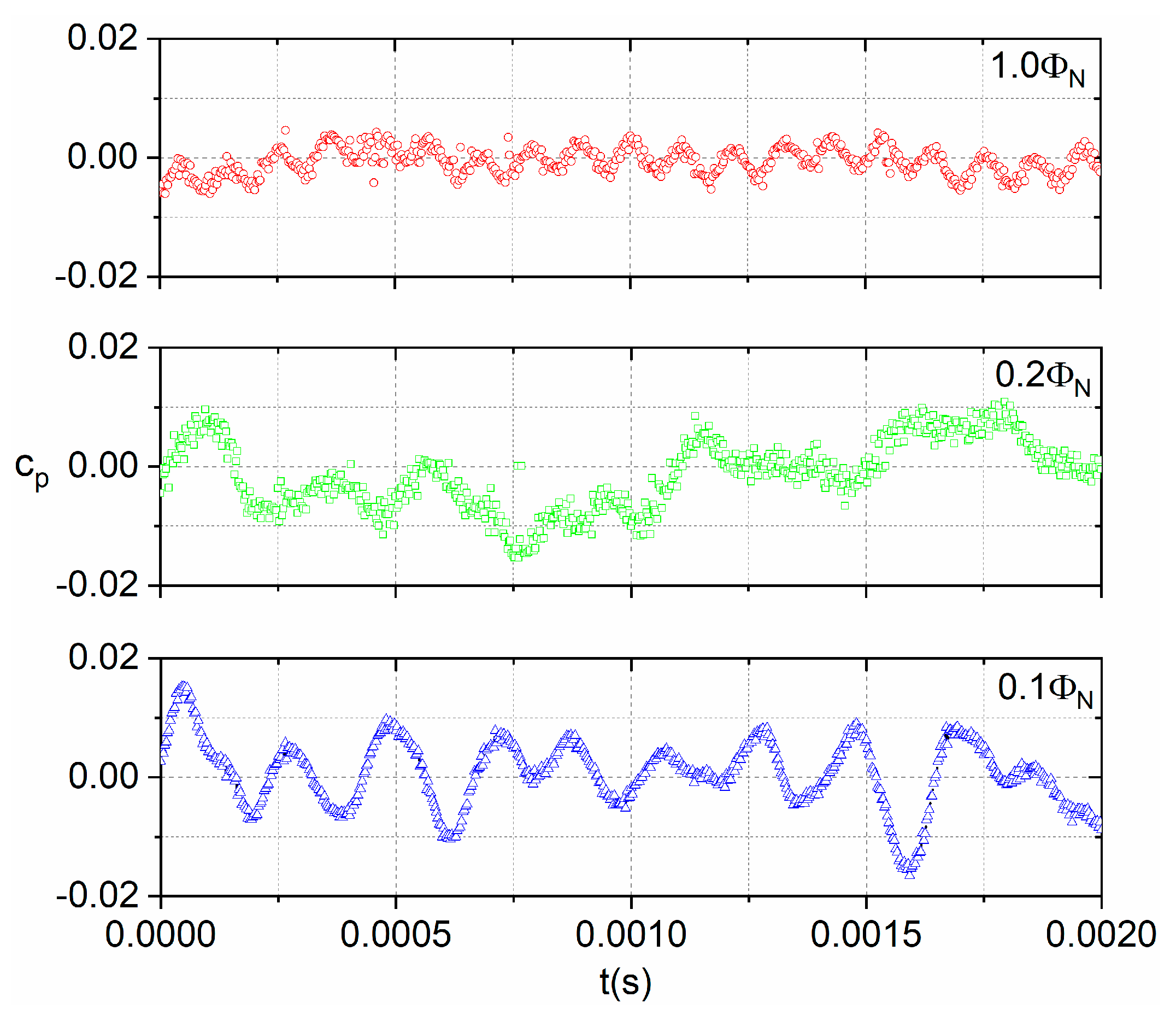
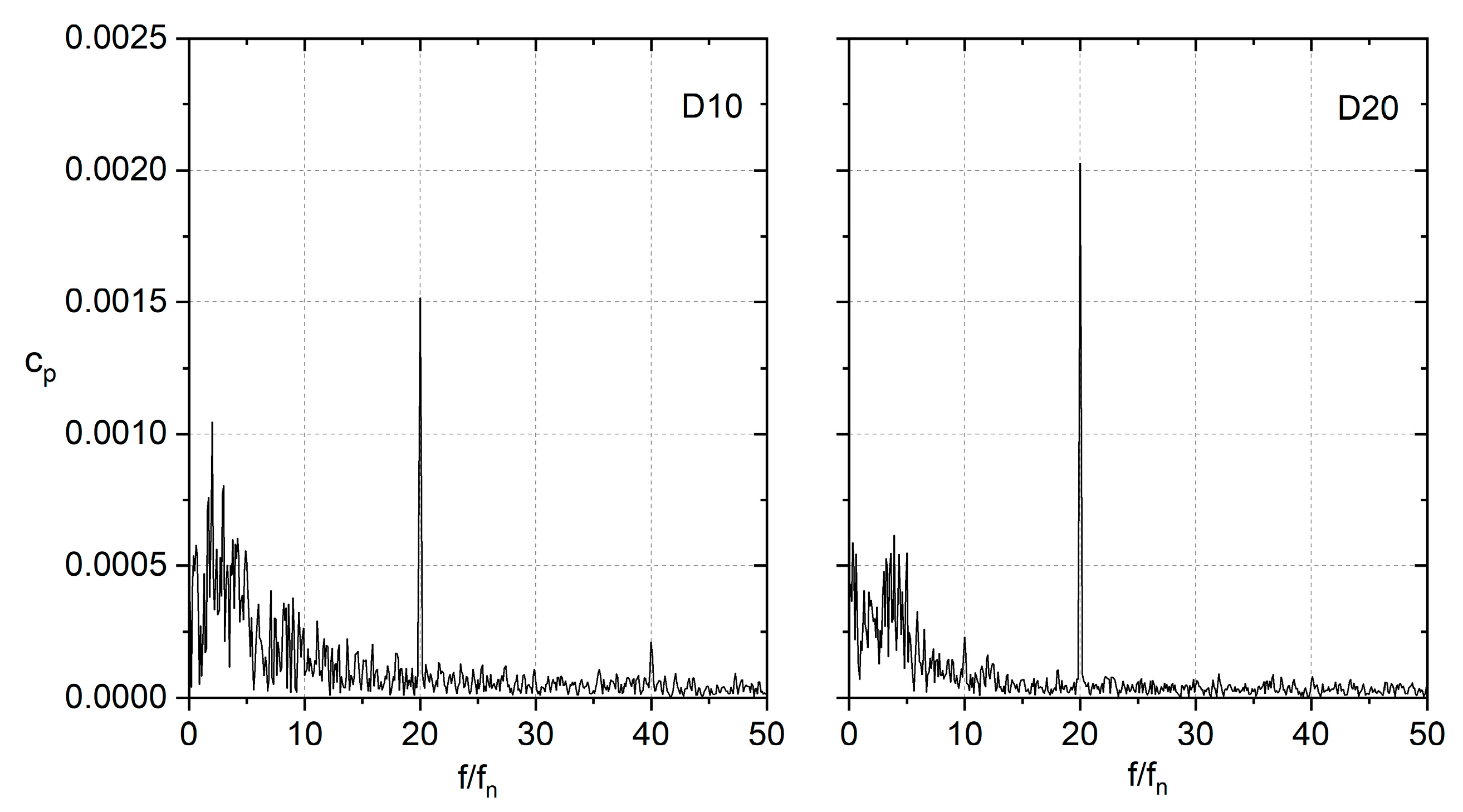
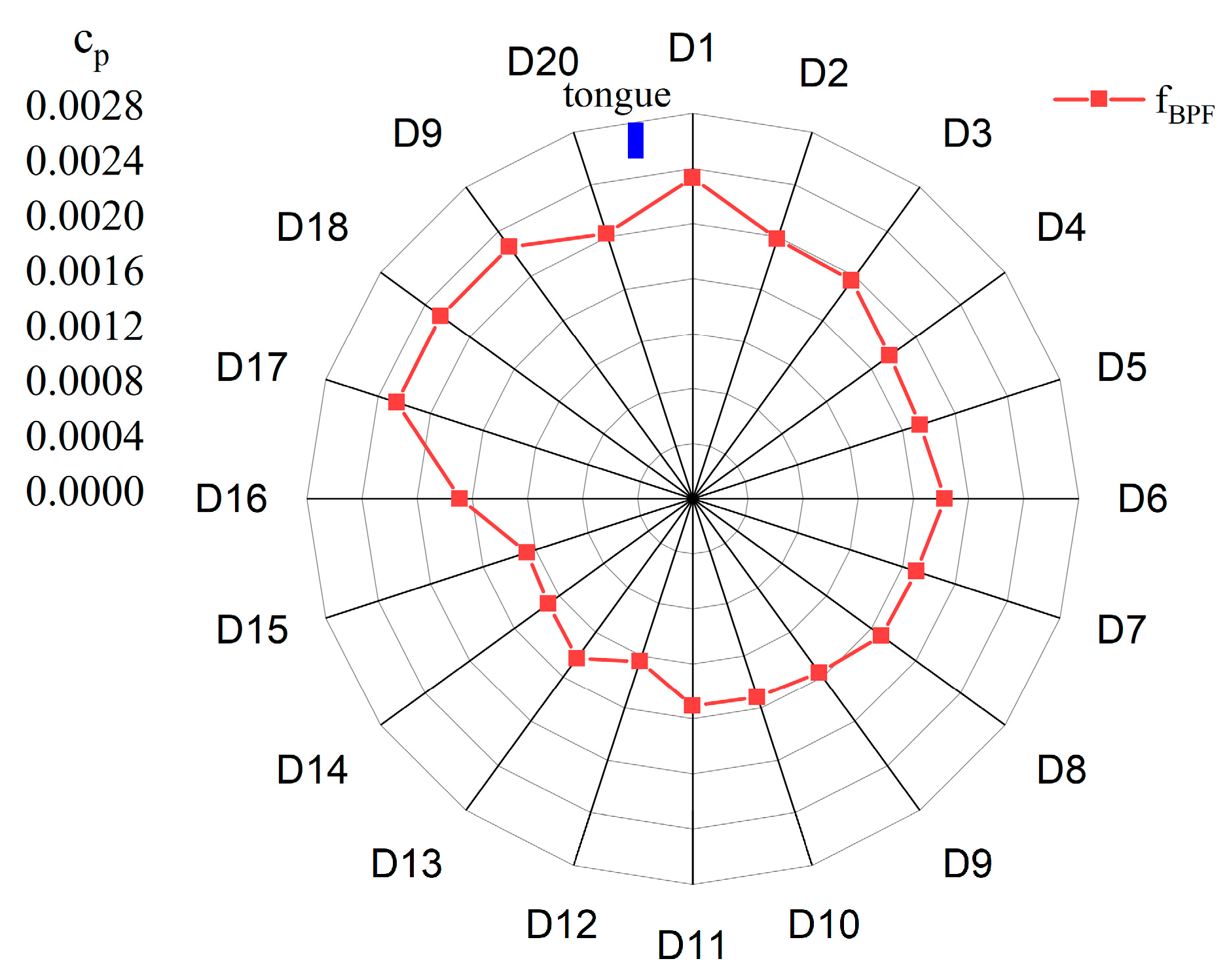
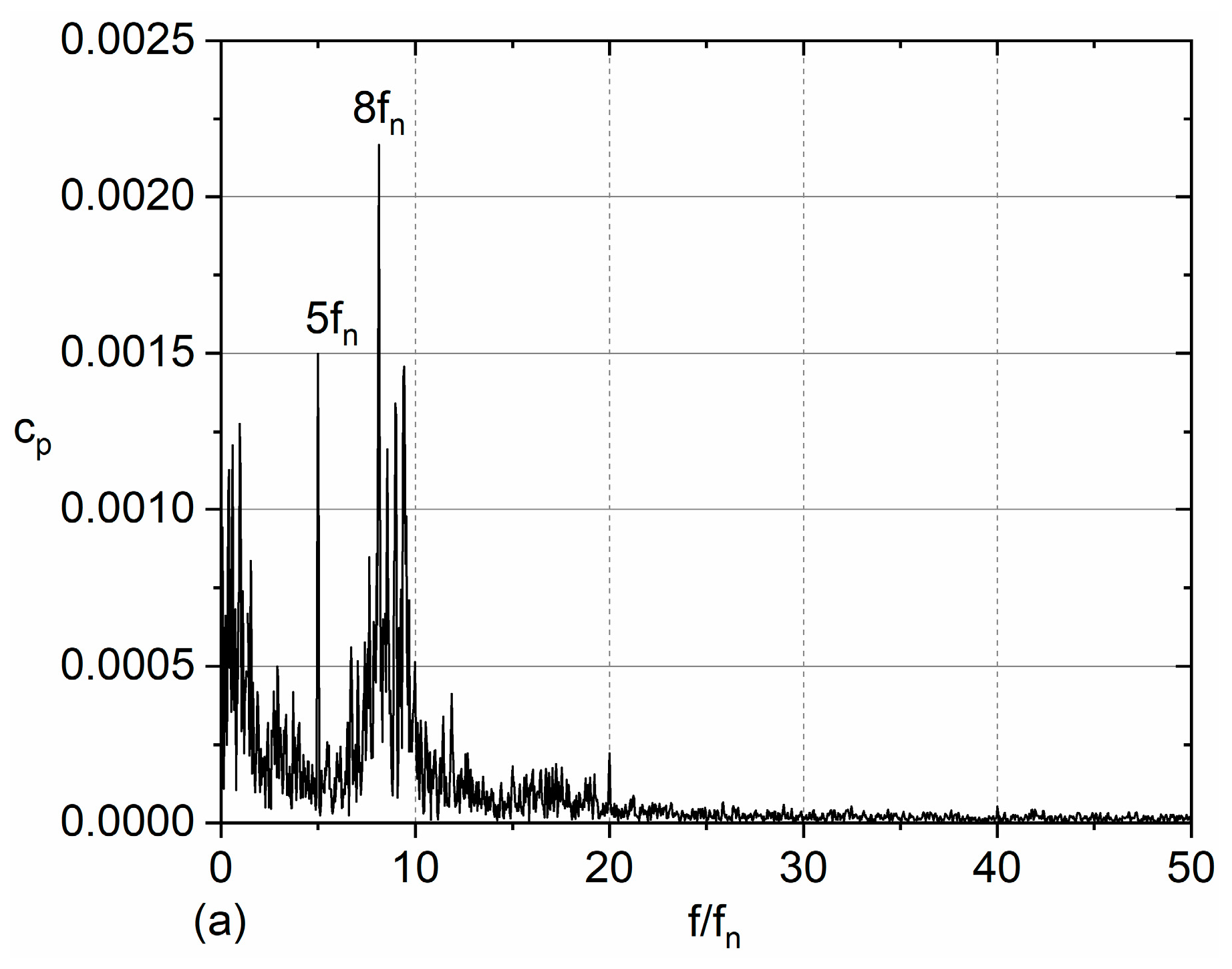

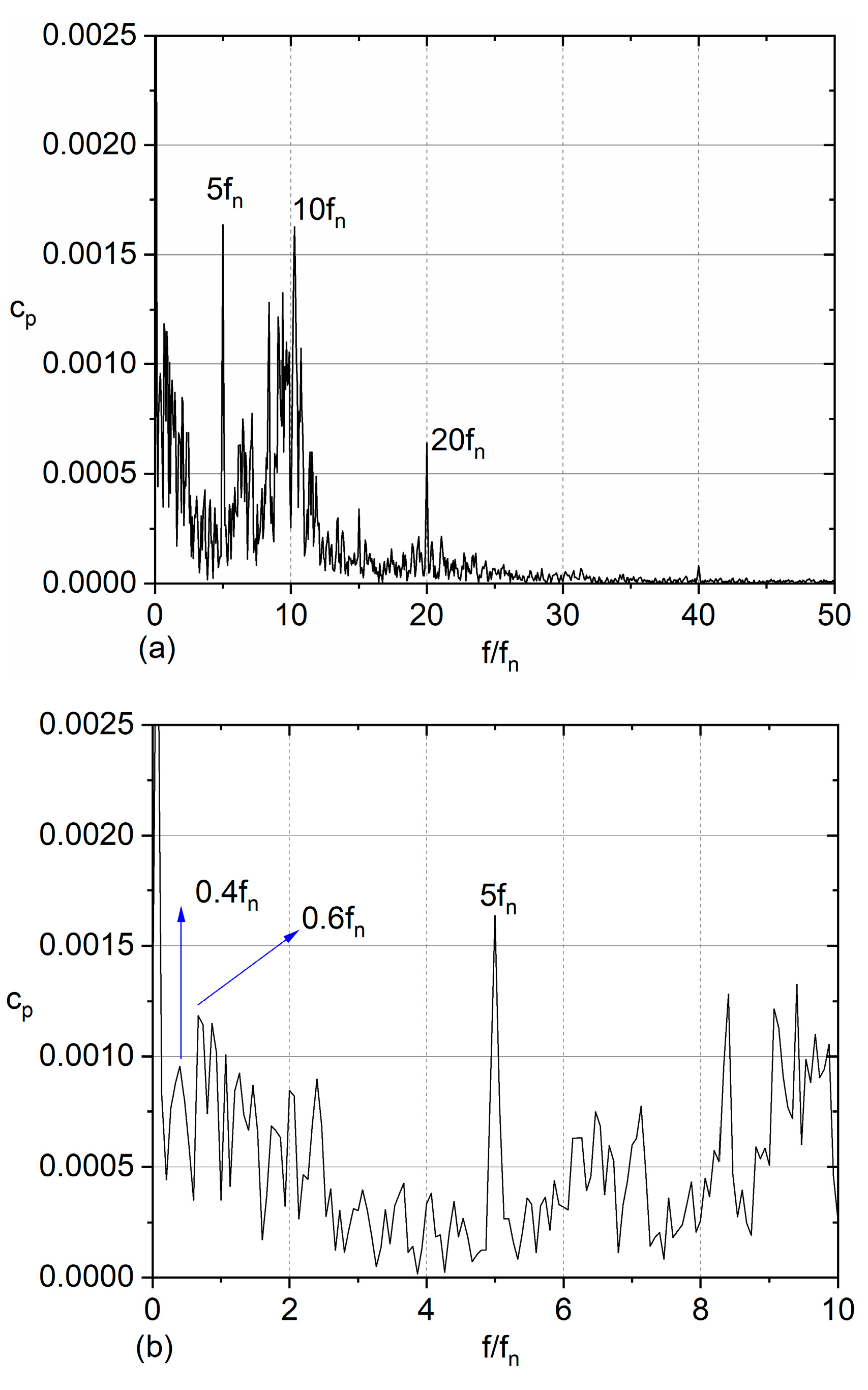
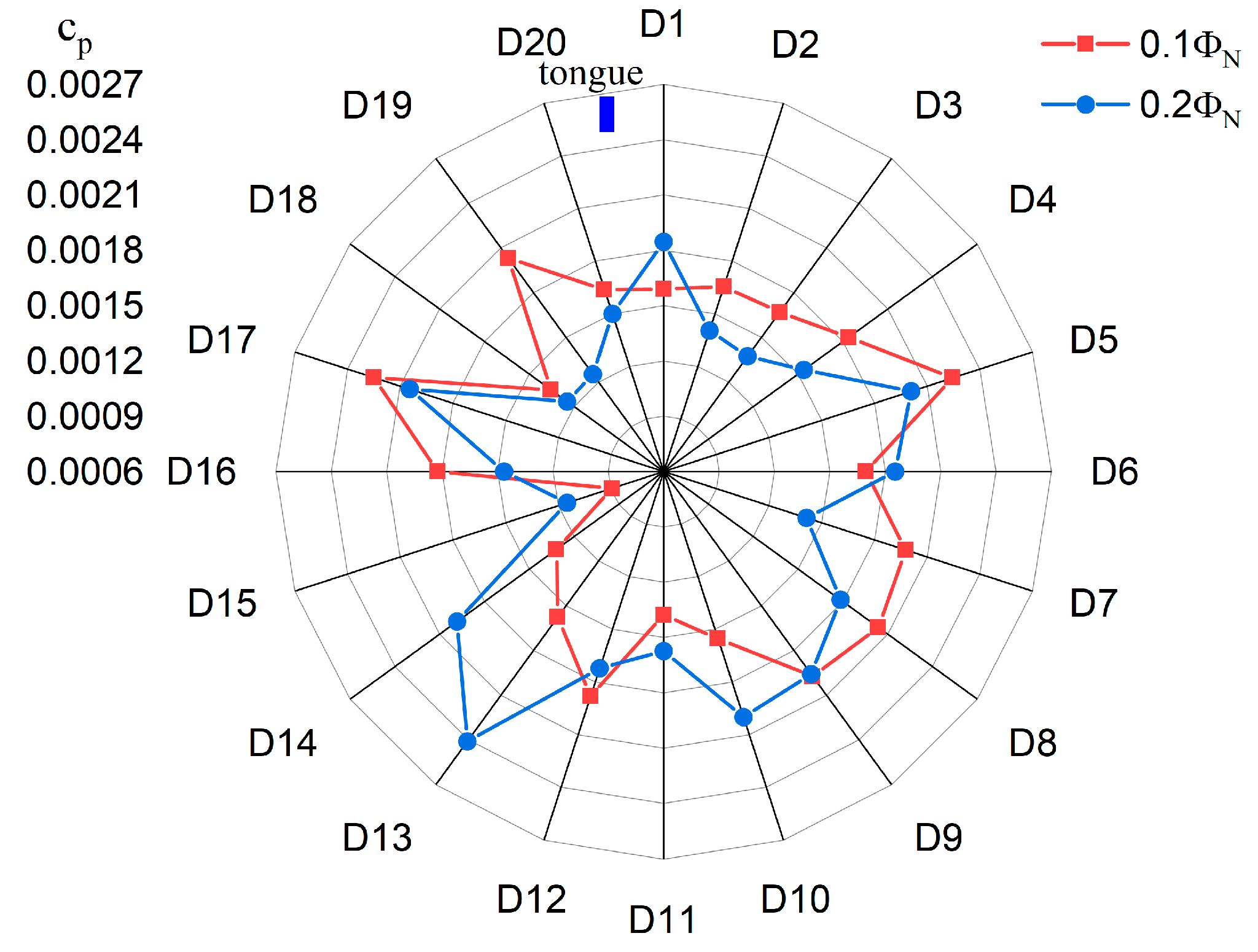
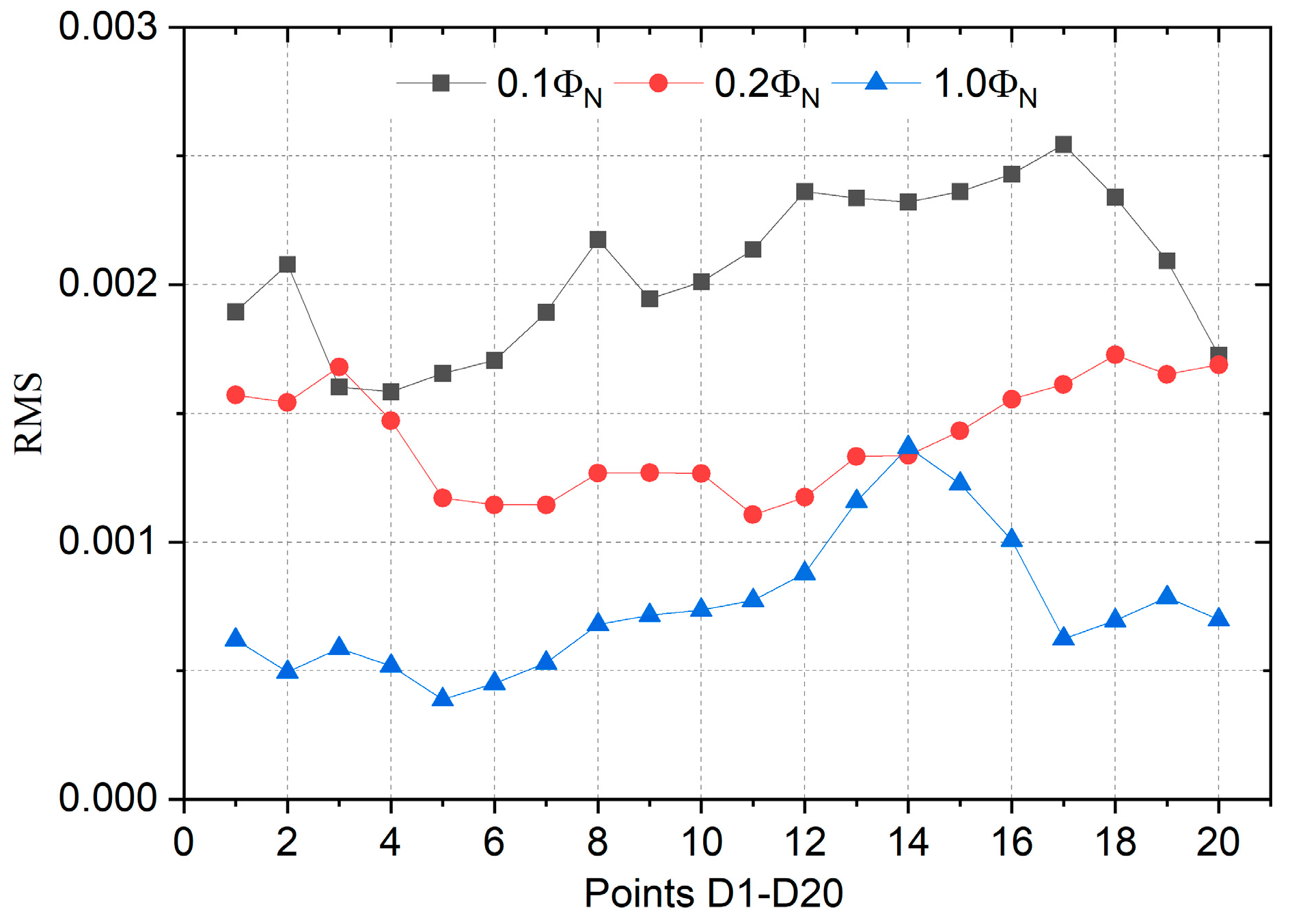
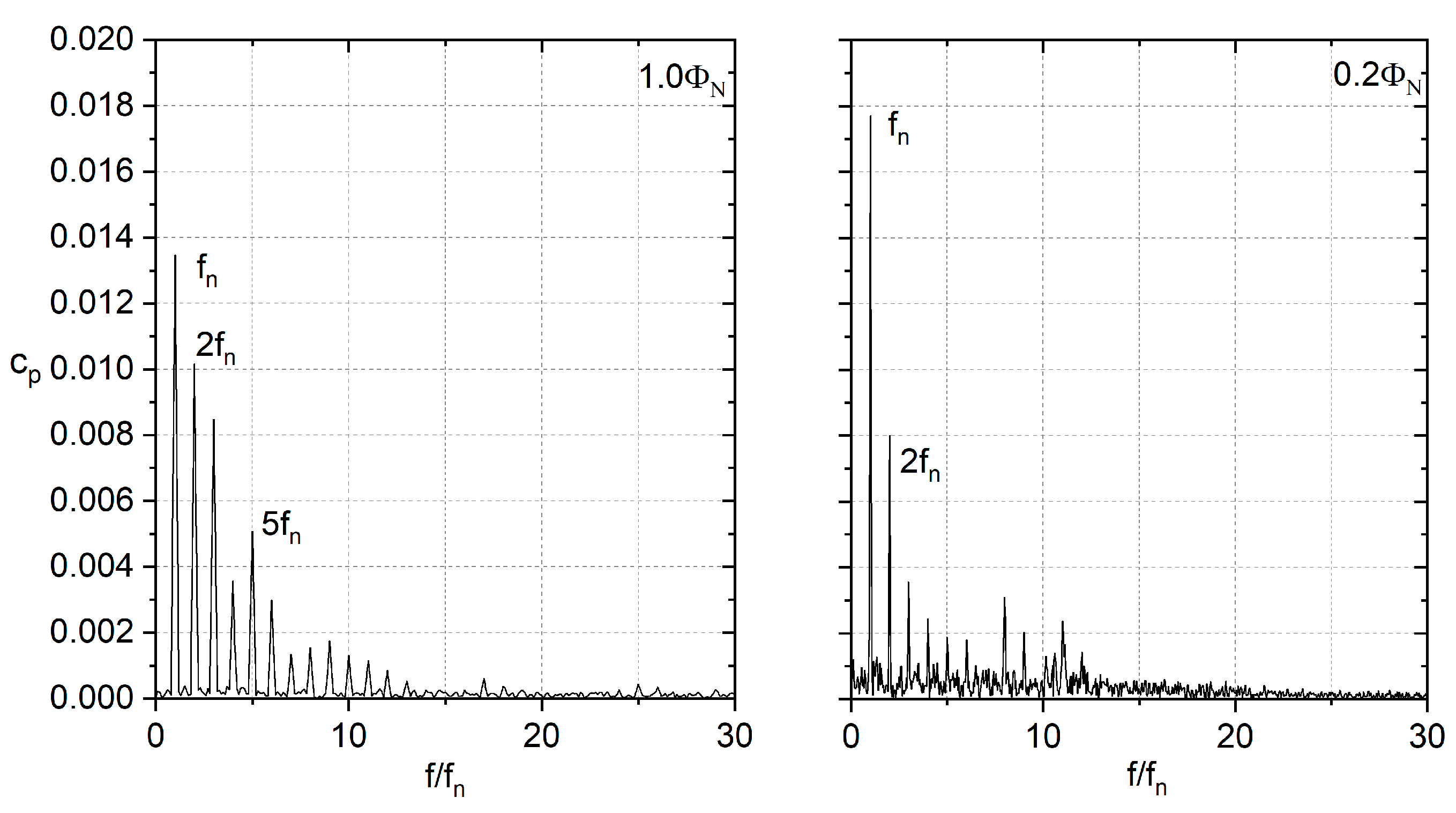
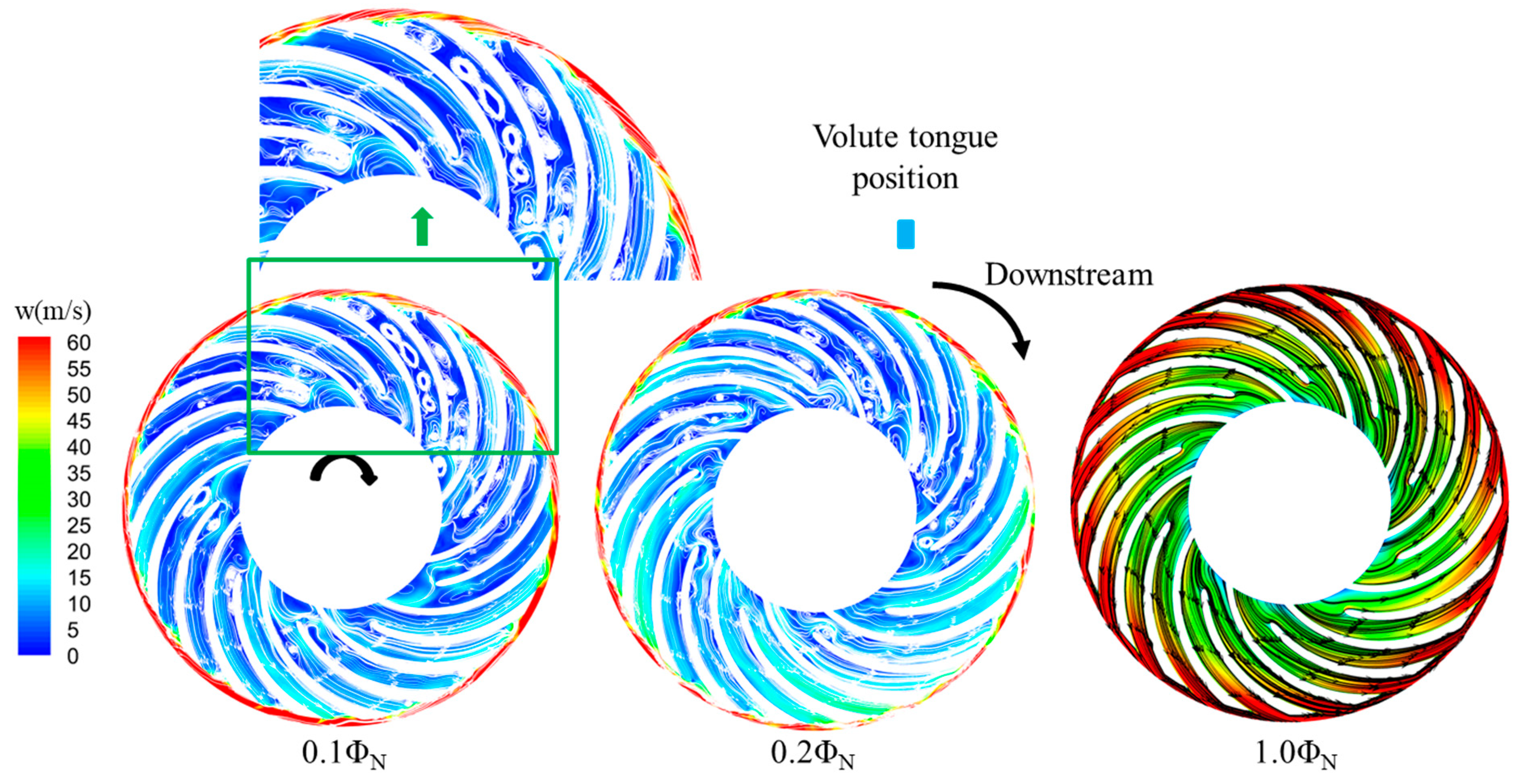
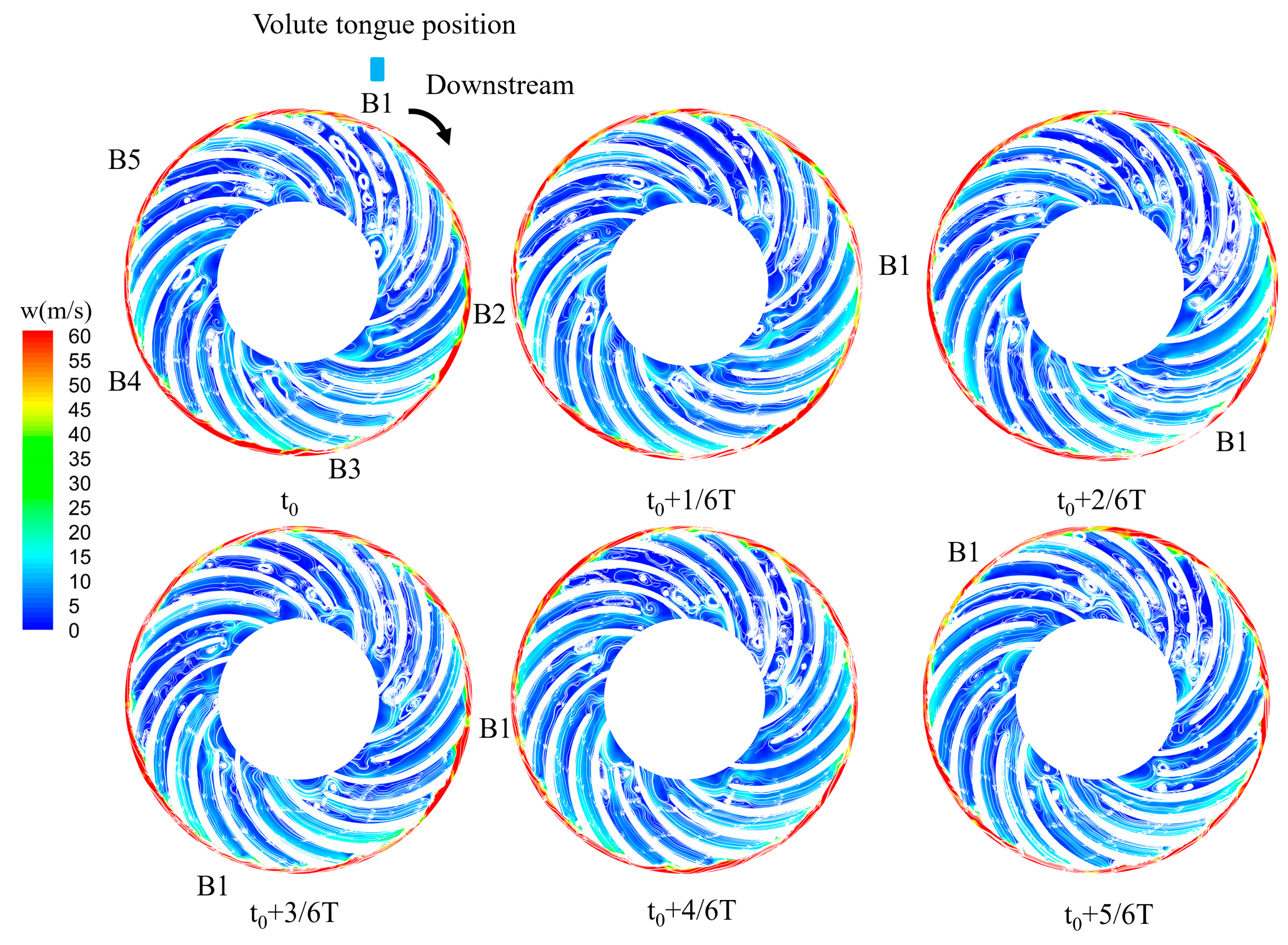
| Parameters | Value |
|---|---|
| Flow rate Qd | 50 m3/h |
| Head Hd | 1500 m |
| Rotating speed nd | 28,000 r/min |
| Specific speed | 50 |
| Total blade number Zr | 20 |
| Long-blade number Zr-long | 5 |
| Middle-blade number Zr-mid | 5 |
| Short-blade number Zr-short | 10 |
| Suction diameter D1 | 30 mm |
| Outlet diameter D2 | 116 mm |
| Volute exit diameter D4 | 30 mm |
| Blade outlet angle β2 | 25° |
| Wrap angle ϕ | 130° |
| Tangential speed at the impeller outlet u2 | 170 m/s |
| Shaft frequency fn | 466 Hz |
| Blade passing frequency fBPF | 9333 Hz |
Disclaimer/Publisher’s Note: The statements, opinions and data contained in all publications are solely those of the individual author(s) and contributor(s) and not of MDPI and/or the editor(s). MDPI and/or the editor(s) disclaim responsibility for any injury to people or property resulting from any ideas, methods, instructions or products referred to in the content. |
© 2023 by the authors. Licensee MDPI, Basel, Switzerland. This article is an open access article distributed under the terms and conditions of the Creative Commons Attribution (CC BY) license (https://creativecommons.org/licenses/by/4.0/).
Share and Cite
Zhou, Z.; Li, H.; Chen, J.; Li, D.; Zhang, N. Numerical Simulation on Transient Pressure Pulsations and Complex Flow Structures of a Ultra-High-Speed Centrifugal Pump at Stalled Condition. Energies 2023, 16, 4476. https://doi.org/10.3390/en16114476
Zhou Z, Li H, Chen J, Li D, Zhang N. Numerical Simulation on Transient Pressure Pulsations and Complex Flow Structures of a Ultra-High-Speed Centrifugal Pump at Stalled Condition. Energies. 2023; 16(11):4476. https://doi.org/10.3390/en16114476
Chicago/Turabian StyleZhou, Zhenhua, Huacong Li, Jinbo Chen, Delin Li, and Ning Zhang. 2023. "Numerical Simulation on Transient Pressure Pulsations and Complex Flow Structures of a Ultra-High-Speed Centrifugal Pump at Stalled Condition" Energies 16, no. 11: 4476. https://doi.org/10.3390/en16114476






